First off, congratulations on realizing that you can grow your own loofah sponge. Most people think they grow in the ocean alongside other sponges, like Mr. SquarePants. Growing loofah is easy in warm climates, but with this guide I'll show you that you can grow your own luffa sponge almost anywhere.
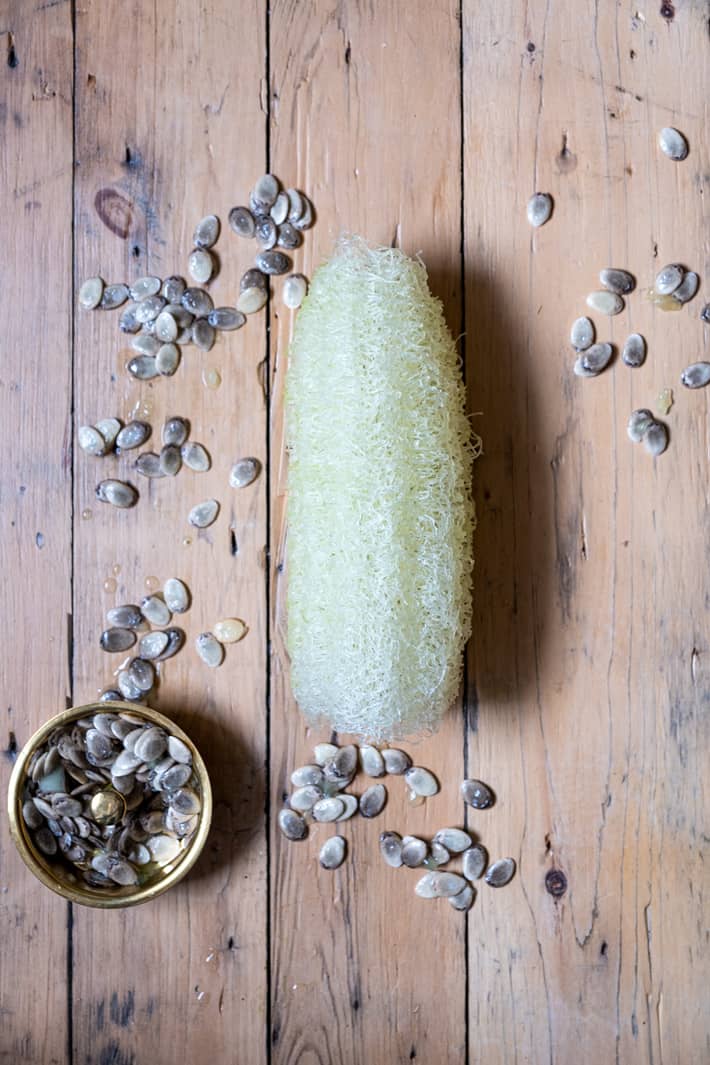
As a matter of fact, no they do not grow in the ocean. Or the sea. Or any other body of water.
The fact that loofah aka luffa is actually a vegetable is always the biggest shock to people when you tell them they can grow their own luffa sponges; the fact that they grow on land, not in the water.
Table of Contents
What IS a Loofah Plant
A loofah plant is a member of the Cucurbitaceae family like squash or cucumber. They have long growing vines that have fruit growing off of them. The plant produces edible fruit which become gourds when left on the vine to mature.
Those gourds dry as they get older, losing all their moisture. When cracked open all that is left inside are the fibres you recognize as a luffa sponge.
There are 2 species of this sponge producing plant.
- Luffa aegyptiaca (this is a smooth luffa, also known as Cylindra, Dishrag Gourd, Sponge Gourd, or Egyptian Cucumber)
- Luffa acutangula (this is a ridged luffa also known as Ridged Gourd, Angled Loofah or Chinese Okra)
They're all the same thing (edible vegetables that grow into fibrous sponges) with different names or a sightly different shape.
- Loofah plants are part of the gourd family and grow on vines that can get to be 30' long or more. Trust me on this.
- The part you're used to seeing is actually the inside fibres of the gourd, which lay beneath the green skin. That's the loofah sponge.
- Immature luffas look like a cucumber or zucchini and are edible when they're very young (4-8" long). They're traditionally eaten with eggs in Asian countries, like in this Serious Eats luffa recipe.
- They are annual vines and need to be replanted every year.
- Luffas are shitheads.
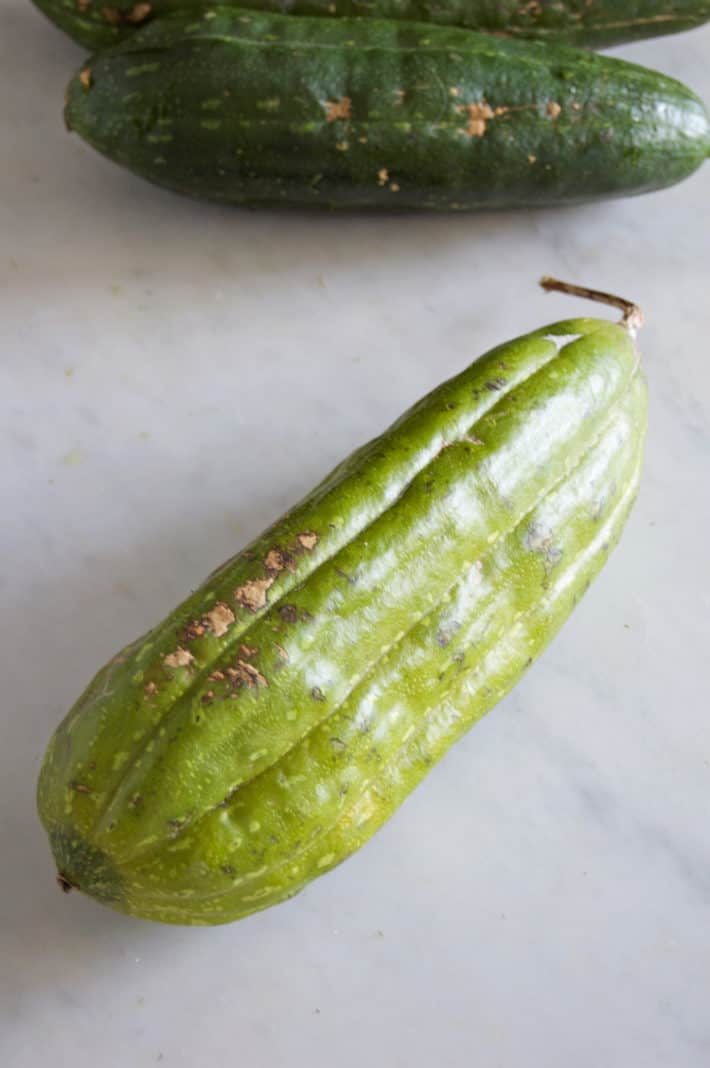
For the past decade I've been growing loofah in my Zone 6 climate. Each year more successfully than the previous year as I figure things out. They need a longggg growing season of 150-200 days. They are also easily frightened. Like you can frighten a Loofah to death.
More on that in a few moments.
To figure out how to successfully grow a loofah sponge, you have to know how to very, very unsuccessfully grow a loofah sponge.
Luckily for you, I have all kinds of experience in that particular area. In fact, I spent the better part of a decade being exceptionally unsuccessful at growing luffa.
Not to brag.
I now have it down to a science and you will now learn from my years of mistakes in this step-by-step guide.
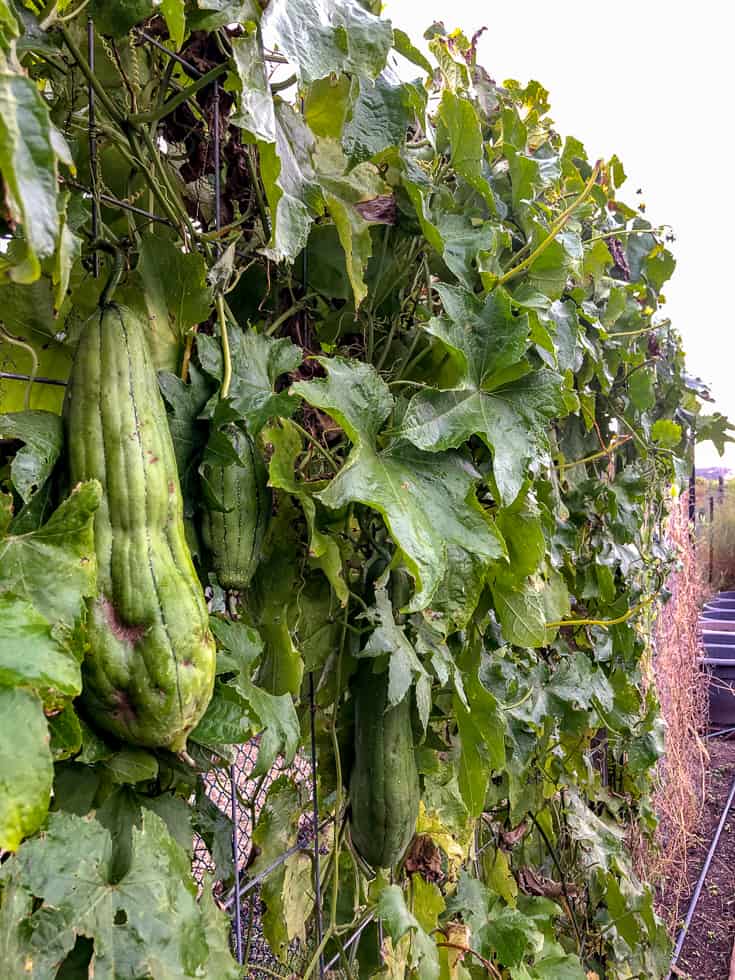
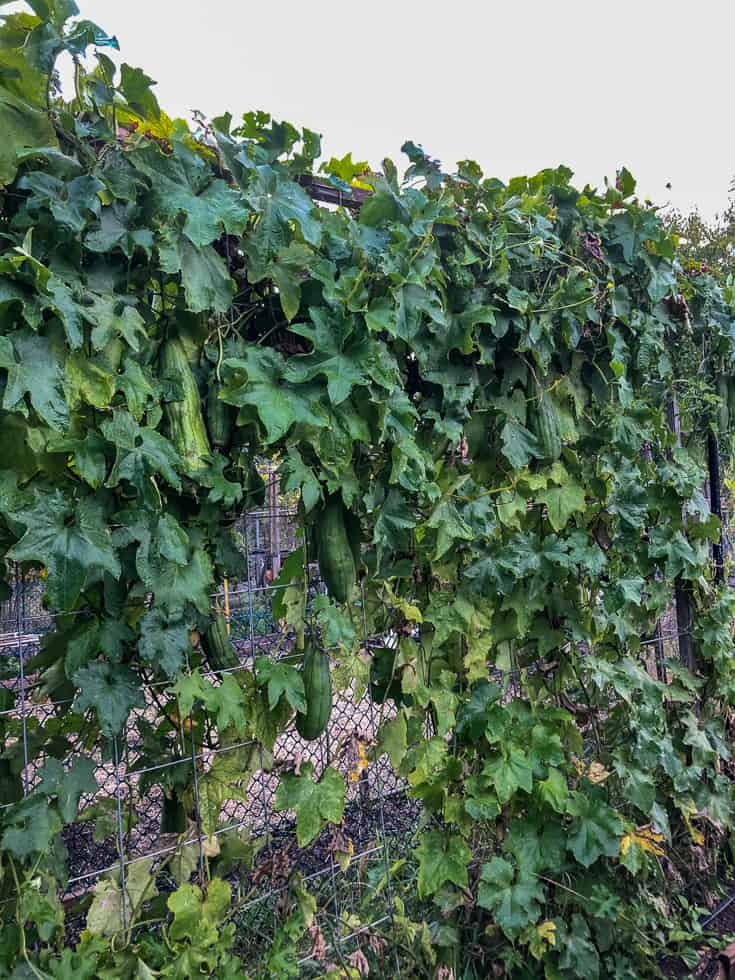
Growing loofah
In colder zones you need to start your plant from seed, grow it indoors until temperatures warm up and then plant it outside on a sturdy structure where the vines can do their thing and the heavy luffa fruit will have support.
Potential Problems
There are 3 main areas where things can go horribly wrong with growing the plant.
- Your seeds won't germinate. Because they're little asshead seeds that hate you.
- Your little luffa seedling goes into shock when you transplant it outside and it dies of fright or at least goes into a month long coma.
- Your vine grows but you never get to the point of seeing fruit before the frost kills it.
I'm going to show you how to overcome all of those issues so you can grow your own organic luffa sponge this summer.
Handy for showers, scrubbing pots and whacking people on the head with.
Planting luffa seeds
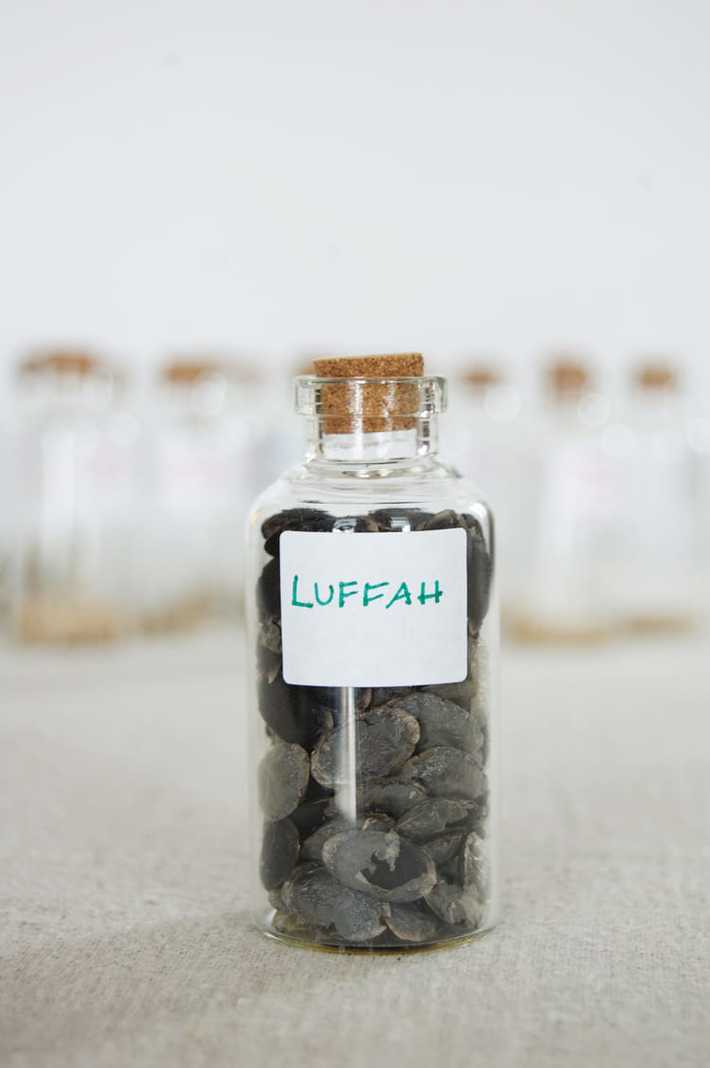
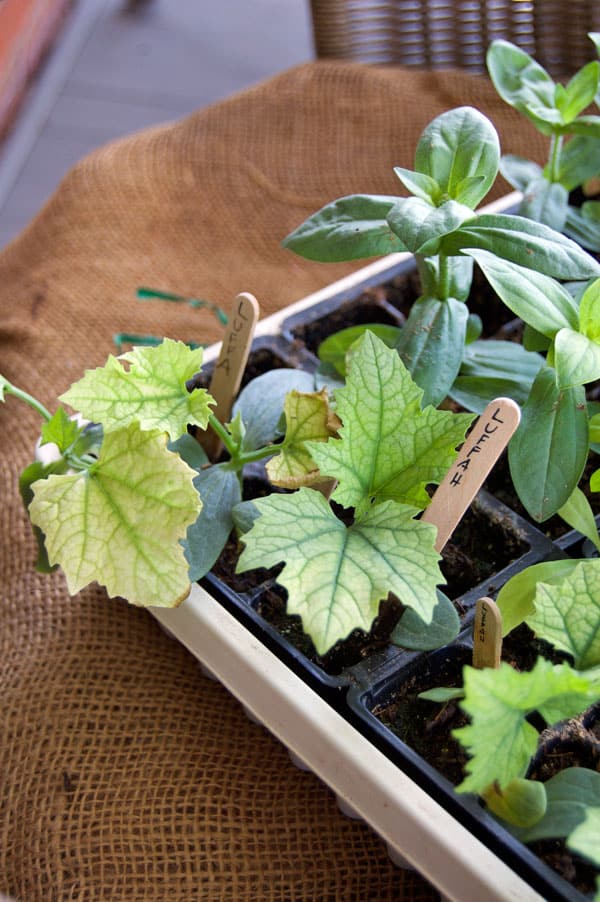
STEP 1 - If you're in a cooler zone, start your Luffa seeds early, indoors, 6 - 8 weeks before the last frost date.
STEP 2 - Use new Luffa seeds and soak them in water for 24 hours prior to planting. Seeds that have been hanging around for years won't germinate well.
STEP 3 - Sow seeds in a 4" pot of moistened soil. Plant ½" deep. Cover with plastic wrap, or a humidity dome just until the seeds sprout. Once sprouted you can remove the dome.
STEP 4 - Germinating luffa seeds on a seed heat pad will increase your success. Sow seeds and then place their pots or tray on the warmth heat pad to germinate.
STEP 5 - For an even BETTER chance of reducing transplant shock, grow in soil blocks instead of pots.
FINAL THOUGHT - Using this method your seeds should germinate within 3-10 days from planting.
TIP - I'm a soil block convert and you can read all about how they work and how to make them in my post on making soil blocks with a soil blocker.
Seed Heat mats
I can't overstate how much a seed heating mat improves germination and growth of your loofah seeds.
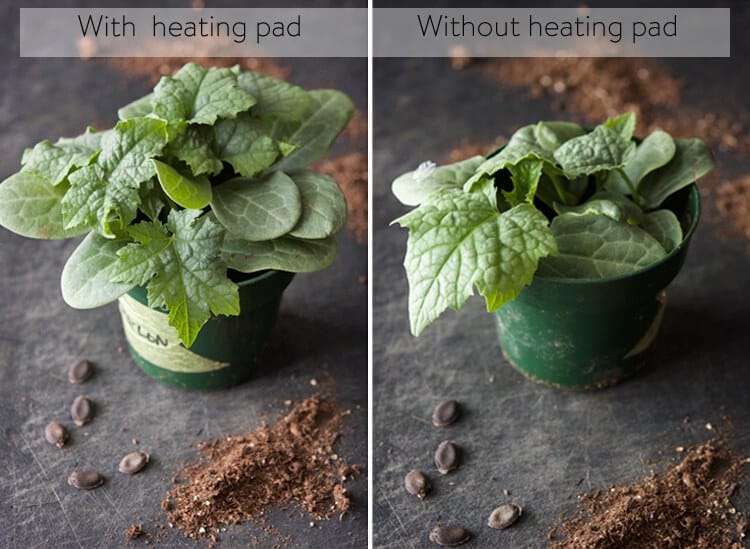
It's also working GREAT for my Sweet Potato slips using my updated sweet potato growing method, tomatoes and just about any other heat loving crop.
Planting out in the garden
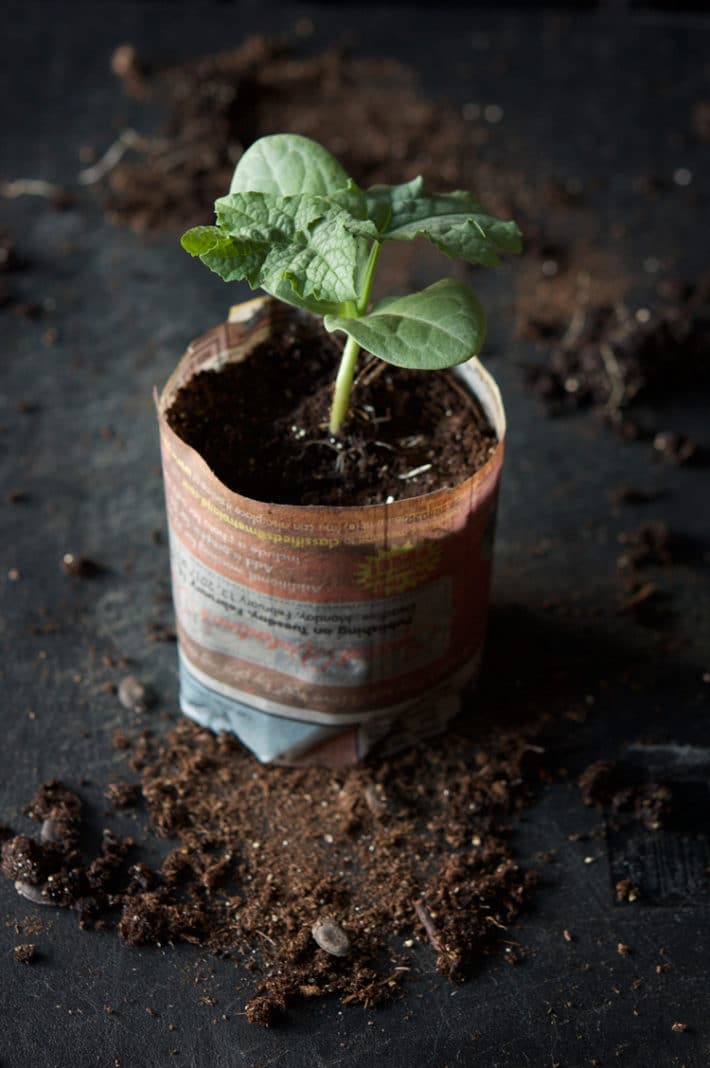
- When the weather is right ( air is consistently around 70 F or 21 C) start hardening off your seedlings. This is more important than with most other plants because Luffa are so prone to transplant shock.
- After a week or so of hardening off, plant your seedlings in an area that gets FULL sun. As much sun as possible. Anything less and you won't get any Luffas.
TIP - If you're unsure of what it is or how to do it, read these steps on how to harden off plants.
- Plant your loofah seedlings at the base of a strong structure that its vines can climb on and cling to. Chain link fence or something similar is perfect.
- If after planting out, a cold snap threatens, cover the seedlings with a vented cloche. Or you can cut the bottom off of a plastic pop bottle and place it over the plant (with the cap removed to allow venting). A few days of cold weather will STOP a luffa from growing and it could take a month before they get over the shock.
- Luffa will produce fruit 3 months after direct seeding, and 4 months after starting seeds inside. They are ready to harvest 6-7 months after seeding.
Alright then, you've started them from seed and planted them out. Now what do you do for the rest of the summer?
Growing Luffa in Containers
- You'll need a 25 - 30 gallon pot or grow bag. If you don't speak "gallons", just look for pots or grow bags that are about 20 - 24" across the top. This will ensure you don't have to water every 30 seconds, and it will hold enough soil to provide enough nutrients to the VERY large luffa.
- Grow one plant per bag. No more than that.
These are GREAT 30 gallon felt-like grow bags.
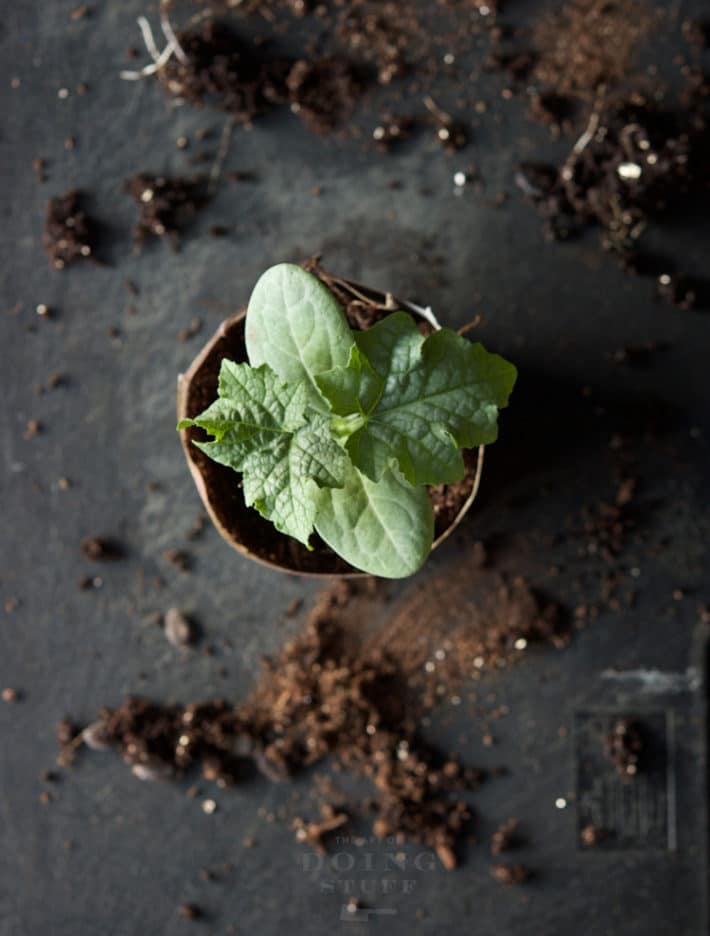
Growing on & summer care
Luffa take 6 - 7 months before they're mature and ready to harvest. That's how long you have to pay attention and take care of them.
Luckily it's mainly just a matter of watering, fertilizoing and keeping an eye out for pests.
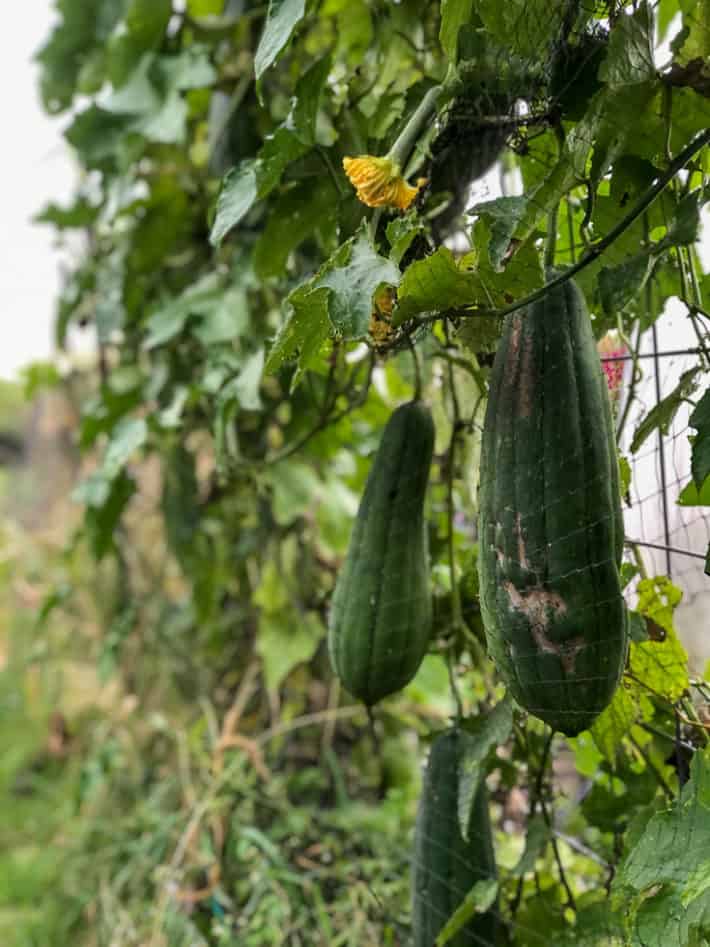
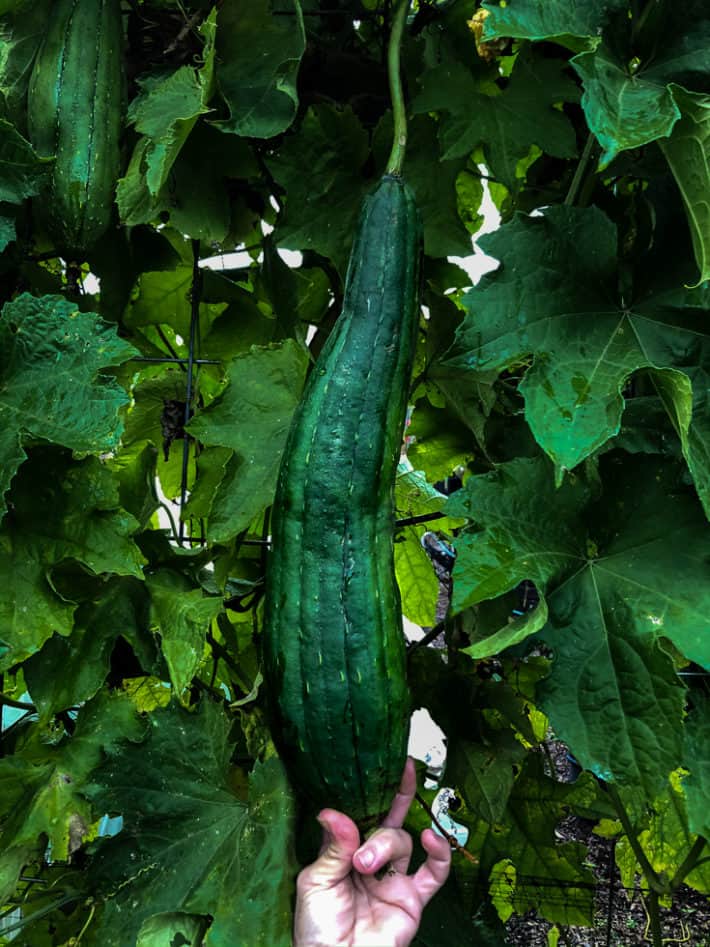
Watering
Keep the soil consistently moist. Don't let it dry out or get oversaturated. Luffa doesn't like surprises. It likes everything to stay the same.
Like I've mentioned before, luffa are shitheads that are plotting against you. If you let them dry out or overwater them, they will rebel against you.
Fertilizing
Before planting, apply 3" of compost over your bed or container.
You can also spring dress your beds with this organic 4-4-4 all purpose fertilizer from Gaia Green. (it's what I use)
Pollination
Like winter squash, luffa have male and female flowers. You can hand pollinate the female flowers using this hand pollination technique to increase your luffa harvest. This is especially helpful if you don't have a lot of pollinators in your garden.
Pinching
2 months before your first frost date (by the middle of August for me in zone 6) you need to pinch away all the flowers and any small luffa on the vine. Continue to do this for the rest of the season.
This is important because it will direct all the plant's remaining energy to growing the luffas that are on the vine now instead wasting it ones that have no chance of becoming harvest size. THIS IS CRUCIAL.
Pests & Diseases
Cucumber Beetle (which cause cucumber wilt)
Aphids
Squash Bug ← link to treatment
Vine Borers ← link to treatment
Powdery Mildew ← link to treatment
Blight
I have never lost a luffa plant to pests or disease, but these are the ones to watch out for. Where indicated I have a link to successful treatments I use.
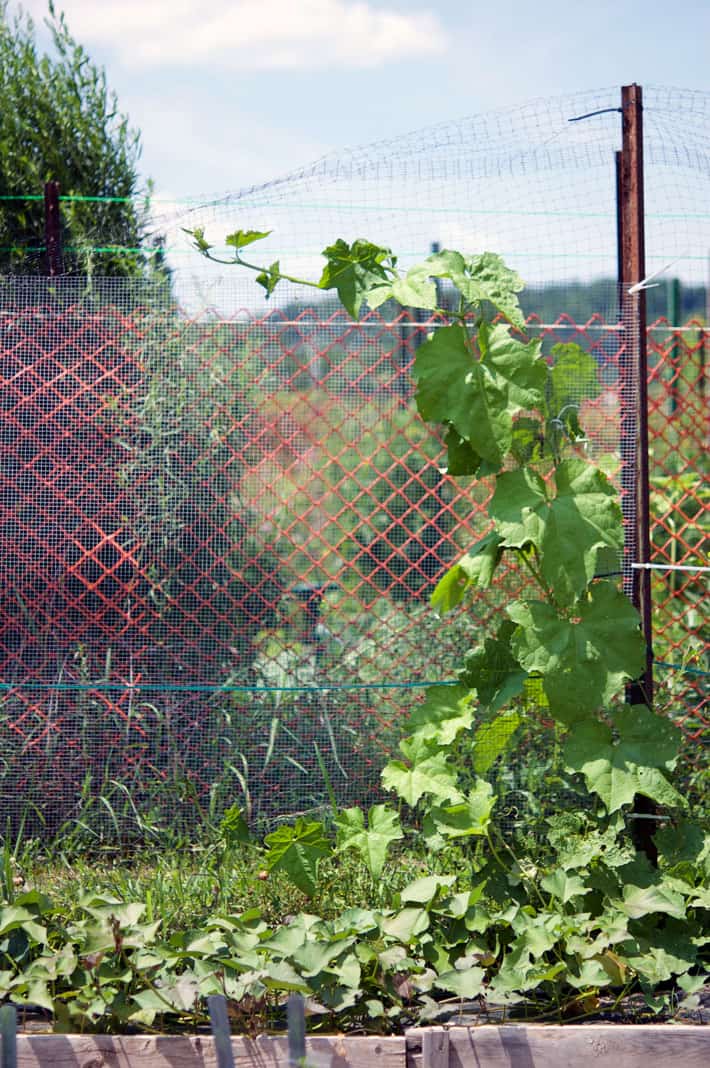
Harvesting
- By October you should have big Luffas. If you live in or above zone 7 your luffas will probably dry on the vine and be brown and light as a feather by October. For zone 6 and below they'll probably still be green. That's O.K.
- Pick your Luffa gourds BEFORE they're hit by frost even if they're still green.
Dry gourds vs Green gourds
Over and over you'll hear that you have to wait until the gourd is dry to pick it. And yes, that's the best time to pick it but it's not the only time.
If you live in zone 6 or below chances are you'll be harvesting them green. The lighter they feel in your hand, the greater chance they'll have fibres inside.
Some green luffas you pick will not have matured enough and when you peel them they'll be fleshy and gooey inside.
But OTHERS will indeed have developed enough to have the coveted fibres.
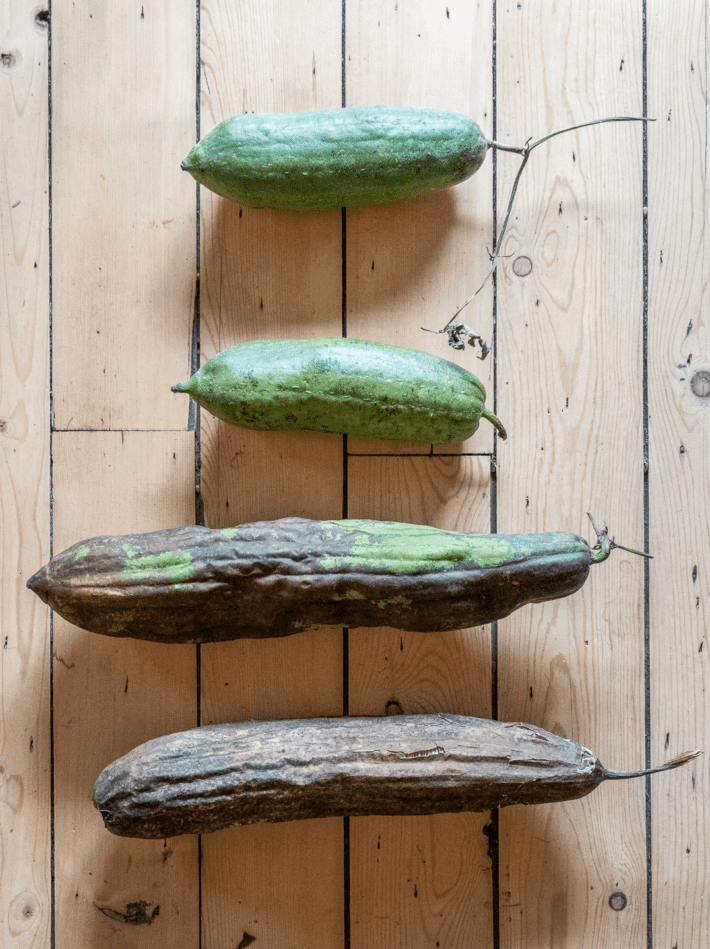
- 1st luffa is immature with spongey flesh inside.
- 2nd luffa is lighter in colour and weight which helps you know it may have developed fibres.
- 3rd luffa is well on its way to drying out and will definitely have a luffa sponge inside.
- 4th luffa is the ideal time to pick. When it's completely dry and you can hear seeds rattling inside.
Like I said, it isn't easy and definitely not for the half assed gardener in colder climates, but if you really want to grow loofahs you can.
Peeling, Processing & Preparing
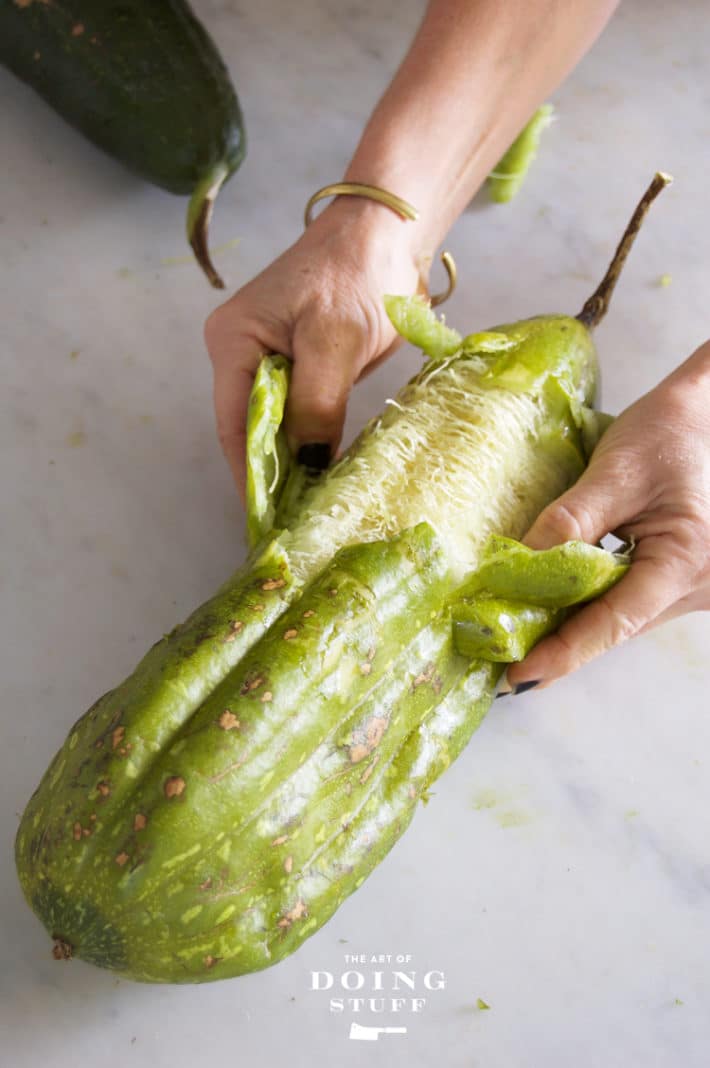
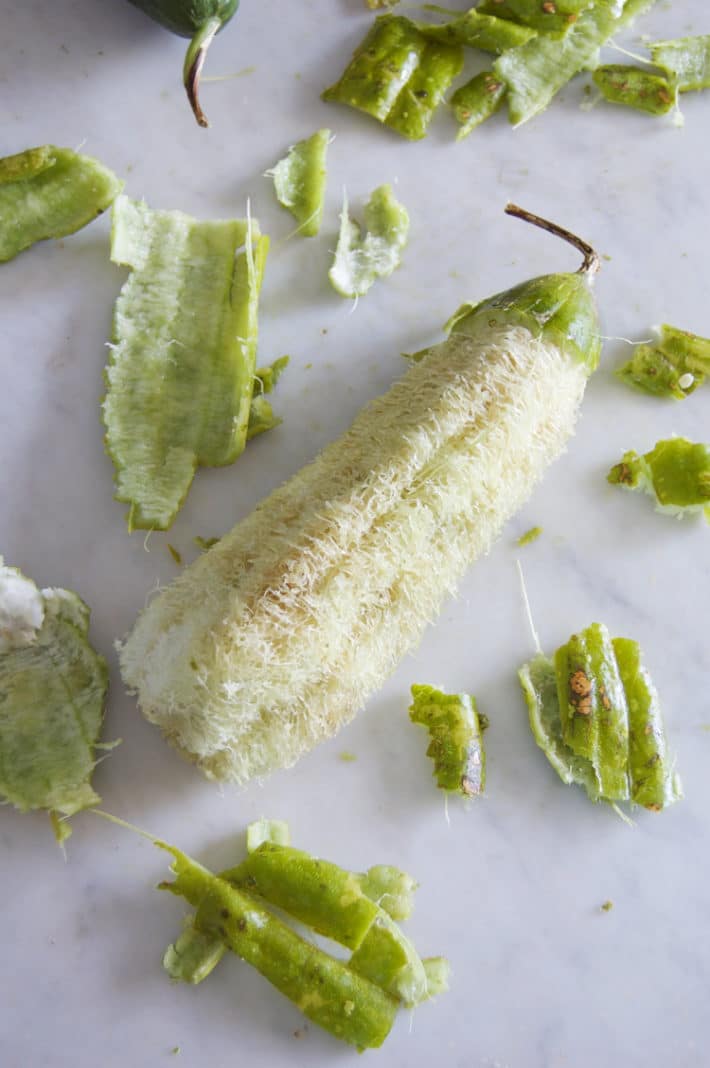
Would you like to save this stuff?
How to process immature (green) luffa
- Lay the gourd on a hard surface like a table. Press down hard on it with the palms of your hands to crack the skin. Do this many times until much of the skin is cracked.
- Press your thumb into the skin by a crack pushing down until you can worm your thumb under the skin. This will separate the skin from the sponge fibres. Kind of like how you would peel an orange that doesn't want to be peeled.
- Rinse the sponge under water once it's released. Squish any wet gooey parts out while you rinse. You want the sponge to be perfectly clean.
- While you rinse and squish, many of the seeds will come out. When it feels and looks clean, let it sit on the counter overnight to dry.
- Once dried you can shake and bat your luffa around to get the remaining seeds out. They'll come out much more easily once it's dried.
- If you'd like a brighter looking sponge you can soak it in a solution of 1 part bleach and 10 parts water. After bleaching, rinse it with clean water and let it dry again.
note: I have quite literally never measured my bleach solution. I just fill the sink with water and glug some bleach into it. But rules are rules and the rule is 1 part bleach to 10 parts water.
Peel green loofah as soon as you pick them. Don't wait for them to dry out - they could rot and discolour.
Saving Loofah Seeds
Each luffa will be FULL of seeds that you can use to grow more luffa next year.
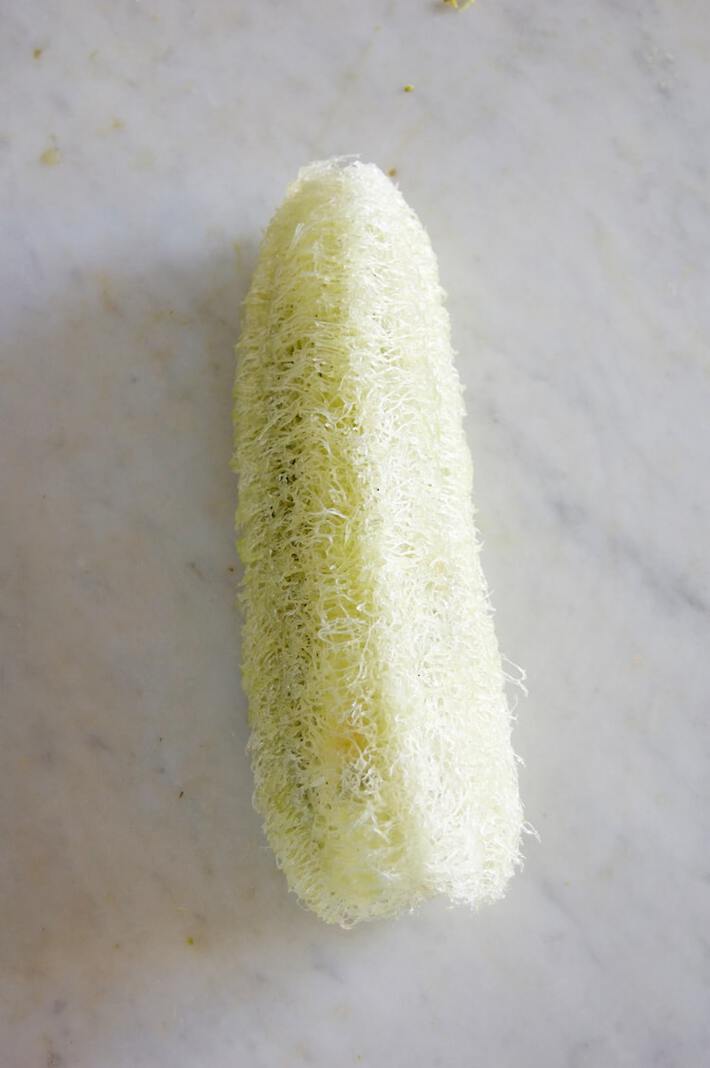
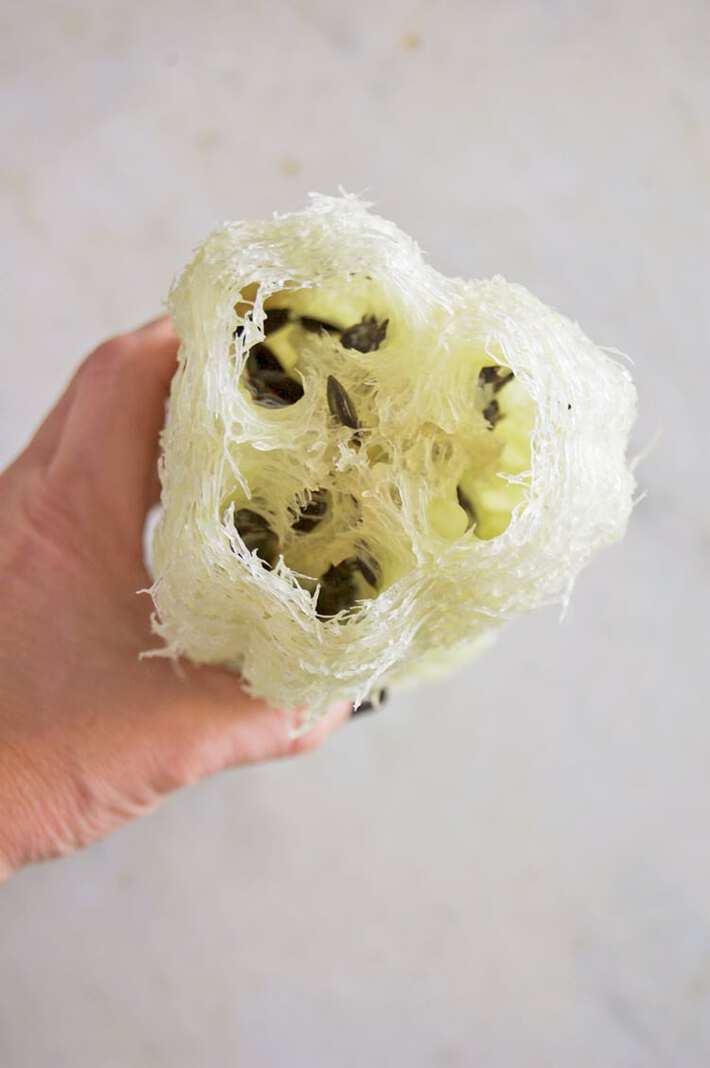
- ONLY the black seeds are viable. White or light coloured seeds will not germinate or grow.
- Once you've set your black seeds aside, feel them. Some will be fat and some will be flat. Fat seeds have been properly pollinated. Flat seeds have not been pollinated.
- Only the FAT luffa seeds will germinate, so those are the ones you need to save for planting.
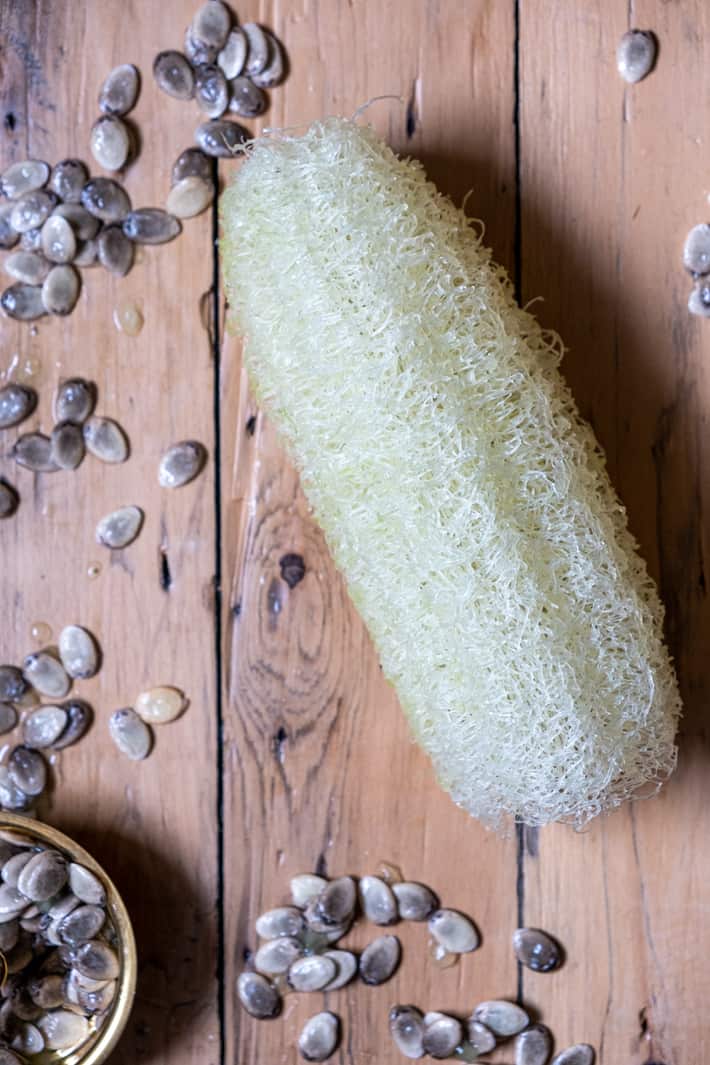
What is a Luffa Sponge Used For?
- In the shower. Either soap up yourself and slough away dirt and dead skin with the Luffa or cut a bar of soap so it fits into one of the luffa channels and it will lather as you scrub with it!
- Pot scrubber. I keep a bowl of these cut into 3 or 4" lengths and use them to scrub pots. When they get dirty they go into the dishwasher. If there's no hope of them getting clean because there are so many bits stuck in them, they go into the compost bin.
- Removing gummy glue from removing stickers off of plastic or glass. Just dab the sticker with oil then scrub with a luffa. Although truly, the best way to remove any sticker is with a hairdryer.
- Anything that needs cleaning by scrubbing.
- Vegetables! Luffas are the BEST vegetable scrubbers.
How to Clean Them
- With bleach in the sink.
- In the washing machine.
- In the dishwasher.
- To maintain the luffa make sure after using them you allow them to stand on end so they can dry properly. Otherwise they'll get musty and gross.
Luffa sponges NEED to be cleaned, especially if you're using them in the shower. Once a week throw your luffa into the wash or soak it in a bleach solution. 1 part bleach-10 parts water. Let it soak for a few minutes and then rinse it.
Where to buy seeds
I got my original seeds from William Dam Seeds in Canada. In the US Baker Creek would be a good place to get them.
Start to finish you're looking at around 6 months or 180 days. The length of time it takes depends on the variety of loofah, but generally it's about 6 months from the day you start your seed to the day you're picking the loofah.
In warm climates you can expect to get 6 sponges from 1 luffa plant. But in colder zones you may only get 3 or 4.
In climates with long growing seasons and in full sun. But they can be grown in cool climates if you use this guide.
If you're a soap maker, you can slice a sponge and put it in the mould before pouring your soap solution. Once it cures you'll have the absolute BEST shower buddy. If you don't count Idris Elba, who of course would be an even better shower buddy.
Yup. But not only are the luffa fruit edible, but the leaves are as well. Just make sure you pick them as a leafy green when they're young. As they get bigger and older they get tough.
If after all of this you've decided you'd rather grow something a little more reasonable, but still fun, I'd recommend growing Buzz Buttons™️ aka toothache plant.
So there. Now I've told you how to do it. Yes I know this post was long, but consider yourself lucky it wasn't a decade.
→Follow me on Instagram where I often make a fool of myself←
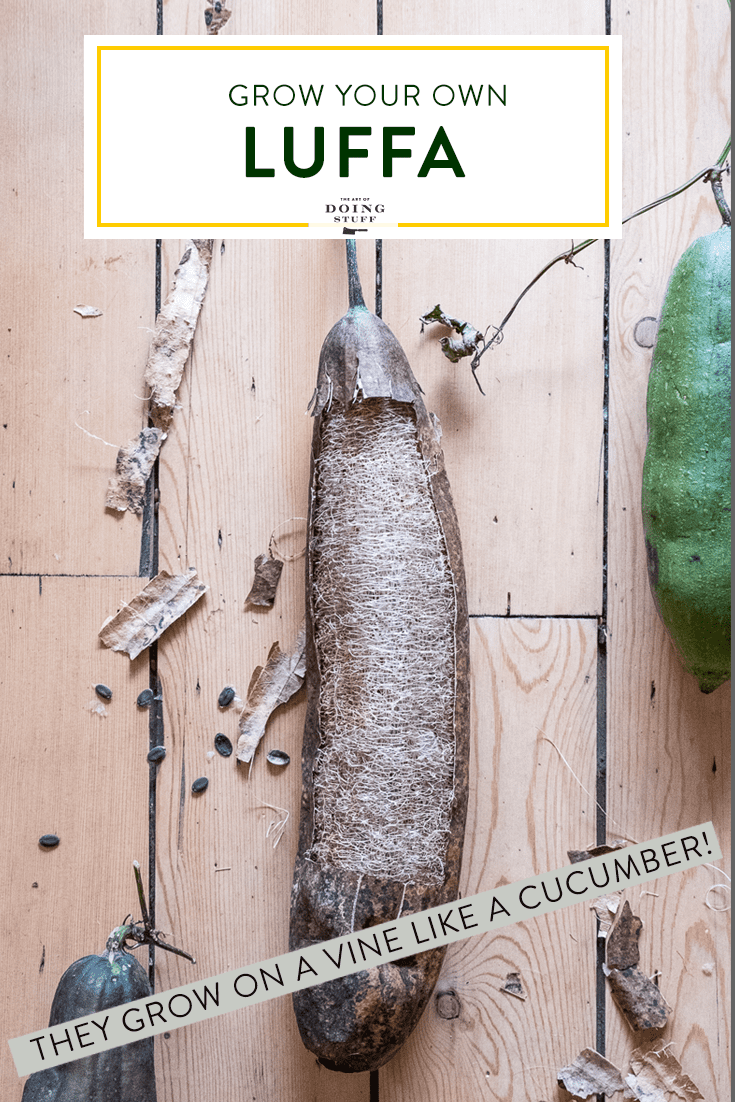


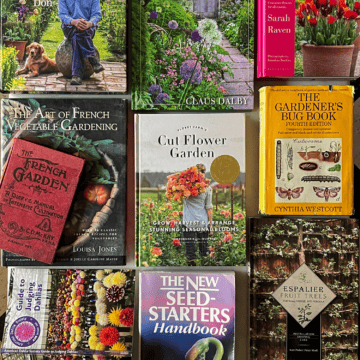
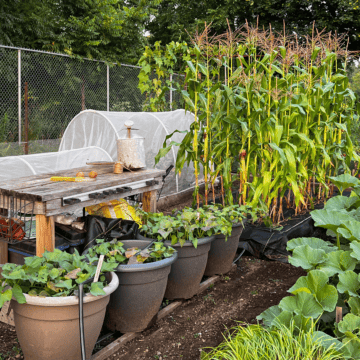
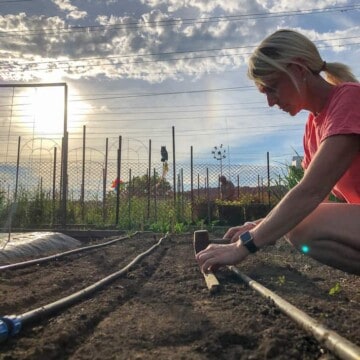
Laura P Hernandez
Thank you so much for the advice. This is the first time I am growing them. I am in zone 4!
Chelsea Stolte
You had me laughing at calling them shits.. now I have to take on the torture of these.
Amy Bellfoy
This was the best thing to stumble upon while researching luffa. Hahah you are so witty. And yup, luffa are shitheads!
Karen
They really are. ~ karen!
Rich
Thanks for your reply a couple of weeks ago. What is a good source of the seeds? Also which of the two varieties do you recommend? I'm growing in Denver and am willing and able to give the plants plenty of organic material and daily care including watering. They'll have plenty of vertical support to vine on. I also plan to start the seeds 6 weeks before the last frost using a sunny indoor location, grow lights, and heat mats. I checked 5 major seed suppliers and they all just said Luffa with nothing about variety.
Last season I saved many seeds but I want to guard against those not being viable. In Denver it seems we get one chance per year for a long luffa season. As you say luffas are shitheads.
Cheers! Thanks for your help.
Karen
Hi Rich. If you have saved viable seed from last year (the seeds will be black and fat) those are the ones you should plant because you know they work for your climate. I always save the seeds from the first luffa that matures to encourage and isolate that quality over the years. You're basically conditioning the luffa to your environment when you do that. Chances are the seeds for sale around you are Luffa Cylindrica. ~ karen!
Rich
Had good luck in 2004 in Denver, 5b/6a. Started in 3 inch peat pots. Transplanted maybe 25. Don't know how many survived because the 15 foot by 20 foot growing area was a jungle. The plants grew on cattle panels held in place by those green metal posts usually employed for barbed wire fencing. I irrigated pretty much daily by a grid of 1 inch PVC pipes placed over well composted soil.
Maybe it was beginners' luck since I read nothing about how to grow luffa. I plan to use your ideas in 2025.
Karen
You did all the important things! Consistent watering, I'm guessing you started them fairly early and you had a good place for them to stretch and strange. Give it another shot! ~ karen
Wendy Freels
Hi, Karen. I grew my first monster -- I mean, luffa -- plant this year. OMIGOSH! Here in Eastern Tennessee, US, you can watch it grow through the day! It's like kudzu! It's completely overtaken my fence at the top of our driveway wall. Several fruits are hanging over the wall; my husband has made all sorts of terrible jokes about them! I can't wait to harvest them. I already have neighbors who want one. Maybe I should sell them? Hmm. Anyway, your article is the best I've found about when and how to harvest them. Thank you!
Karen
Nice work! Most of mine are very small this year for some reason. There's nothing more fun than luffah harvest day. Don't promise too many of them away until you see how many actually are formed and useable. As I've mentioned luffa have a reputation for being assheads. ~ karen!
Wendy Freels
LOL........I'll keep that in mind. :)
Kandace Perkins
Hi,
Have you ever tried drying loofah in the oven? It's supposed to make it easier to peel the green ones. I live in Brantford and my two plants produced seven loofahs. I just discovered two of them on the ground this morning. The entire plants broke slightly loose from the mesh trellis (I know now that it wasn't strong enough).
Anyway, just wondering what your thoughts are on oven drying.
Thanks!
Karen
Hi Kandace! I actually don't think it's necessary. I really don't find them much more difficult to peel than dried ones. ~. karen!
Mark H
Hi Karen,
I've just moved into my girlfriends friend's house for the week on holuday in Guadaloupe in the French caribbean. only to discover some very large brown fruits hanging from a vine in a cashew tree in the garden. Pulled one down and opened it to find.... Well I'm sure you can guess based on the article I'm commenting on.... but yes a 25cm loofa inside.... Thank-you for your super informative article... You are compleatly right I, like my dad who always had one in the bathroom when I was going up, thought they grew in the sea. I'm now in the process of deaseeding this beast of a loofa and hope to take it back home with me to France in 7days time. I'm probably going to leave it as I picked it and keep it dry until I get there, unless you see this response and can give me some better advice?
Once again thanks for your super informative blog obviously all the parts of the article on growing loofas do not apply to me but I'll be sure to pass on the details to the girl who lives here... But the section on processing and keeping your loofa in a good condition were amazing... No more plastic shower flower (fleur de douche as thé french call it) for me! ;-) 😁😁👍
Justin
hey. first time grower here (in Australia). I have a vine full of large, fat loofa's. We are entering our cold season now, and most are just starting to brown. A few of them in the later stages of browning were full of liquid (like hanging water ballons) - and on piercing the 'bum' of the loofah, expelled a tonne of smelly loofa-juice. Is this the proper practise for when trying to dry loofahs, to allow for moisture release?, because all the other's look to be heading down the same path and I reckon that much liquid would have rotted whatever was inside pretty quickly.
Cheers!
Karen
Hi Justin! Is it possible they got touched by frost? If they did that could cause it. Other than that though, I have absolutely no idea! I've never had any smelly loofa juice. They don't need to be entirely brown to pick. I'd pick them all as soon as you can. The inside is filled with lots of "guck" that you need to rinse out if you pick them before they brown, but it isn't particularly smelly or liquid. Keep me updated, I'm curious. ~ karen
Byron Berwick
Was given some seeds last spring. Planted them first week of June and 3 came up. put up 8 foot tripod to climb. Now there are 2 at 18 inches and 4 or 5 a foot or more long No frost yet {tonight , late for zone 5. Trenton On. Ca.} Covered them up. Two big ones are getting light, but still green. Will do better next year.
Ps The young ones are tasty eaten raw.
Chelle
Love your sense of humor, and the detail you share! Be still, my heart! I am looking forward to giving this a whirl!
Mary Beth Grove
Oh my gosh- you’re a riot! What an enjoyable and very informative read! I’m going to try this on my farm as an accessory for my Sunny Meadow Farm Soaps, LLC . Thank you!!!!
Karen
That's a great idea. (for a second I read your farm name as Sunny Meadow Soap Farm.🤣 ). So I figured if you can grow soap, luffa should be a breeze. ;) ~ karen!
Lois Luckovich
I will be growing loofahs for the first time next year and I look forward to the challenge. I'm in zone 7a and hope to have success. I will be putting up a greenhouse first thing come Spring. Thanks for the in-depth tutorial
Karen
You'll do well in Zone 7a! Good luck. There's nothing more fun than the surprise of peeling your first luffa and finding a sponge inside. ~ karen!
Darren
Thank you for your information . I grew luffa years ago and managed to get some luffa but I was told to let them dry in the vine. And that’s did not turn out. So I am going to start them here 7b in May outside in Pots
I am looking forward to success this year !
Angela
Managed to grow one small fibrous luffa (and one non fibrous one) way up here in Kakabeka Falls, Northern Ontario! Thanks so much for the detailed information. Our growing season up here is significantly shorter than southern Ontario, so your tips were critical. I’m confident that at least a few seeds are viable for next year, so I’ll be trying again next year. So much fun!
Karen
Congratulations! I know that feeling of elation. I bet you just about cried when you peeled it and found it full of fibres. :) Next year you'll just have to do everything you did this year - but better.😆 ~ karen!
Bec
Thank you for this information It is exactly what I need. I live in Michigan SO,wish me luck!
Bec
Thank you for thus information is exactly what I need I live in Michigan SO,wish me luck!
Karen
You're relatively close to me in Southern Ontario Bec. You'll be fine! :) ~ karen
Erica F
Thank you for this!!
I currently live in Texas (8a), and I’ve been lucky enough to get 8 luffas on my vine on my first try. BUT, I leave Texas in 10 days-moving to NY. I am SOOO not looking forward to it, because I’ve only ever lived in TX. This has helped me get my game plan going for next year’s luffa plant, as well as others!